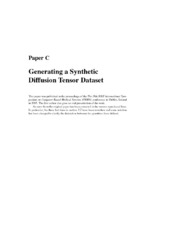| dc.contributor.author | Bergmann, Ørjan | eng |
| dc.contributor.author | Lundervold, Arvid | eng |
| dc.contributor.author | Steihaug, Trond | eng |
| dc.date.accessioned | 2008-10-16T12:22:21Z | |
| dc.date.available | 2008-10-16T12:22:21Z | |
| dc.date.issued | 2005 | eng |
| dc.Published | Computer-Based Medical Systems, 2005. Proceedings. 18th IEEE Symposium on 2005: 277- 281 | en |
| dc.identifier.isbn | 0-7695-2355-2 | en_US |
| dc.identifier.issn | 1063-7125 | en_US |
| dc.identifier.uri | https://hdl.handle.net/1956/2799 | |
| dc.description.abstract | During the last years, many techniques for de-noising, segmentation and fiber-tracking have been applied to diffusion tensor MR image data (DTI) from human and animal brains. However, evaluating such methods may be difficult on these data since there is no gold standard regarding the true geometry of the brain anatomy or fiber bundles reconstructed in each particular case. In order to study, validate and compare various de-noising and fiber-tracking methods, there is a need for a (mathematical) phantom consisting of semi-realistic images with well-known properties. In this work we generate such a phantom and provide a description of the calculation process all the way up to voxel-wise diffusion tensor visualization. | en_US |
| dc.language.iso | eng | eng |
| dc.publisher | IEEE | en_US |
| dc.subject | Biomedical MRI | eng |
| dc.subject | Brain | eng |
| dc.subject | Image denoising | eng |
| dc.subject | Image segmentation | eng |
| dc.subject | Medical image processing | eng |
| dc.subject | Phantoms | eng |
| dc.title | Generating a synthetic diffusion tensor dataset | en_US |
| dc.type | Peer reviewed | |
| dc.type | Journal article | |
| dc.identifier.doi | https://doi.org/10.1109/cbms.2005.58 | |
| dc.subject.nsi | VDP::Matematikk og Naturvitenskap: 400::Informasjons- og kommunikasjonsvitenskap: 420 | nob |
